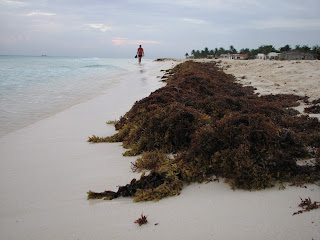 |
| Sunrise at Playa del Carmen, Quintana Roo, Mexico |
We walked the beach this morning before the sun came out.
Out of our hotel room by a quarter after 5:00 we pass through quiet, empty,
mostly dark streets until we get to the dock, where yesterday we watched
streams of tourists return to their cruise boat. As we walk the beach and look
out across the horizon, we can see the soft glow of Cozumel lights. Pockets of
sky light up as lightning falls in the distance. There is no thunder, but we
can hear the thud of dance music farther down the beach. We keep walking,
letting the warm, dark water lap against our toes. As we draw closer to the music
and the light, we pass three entangled couples on the sand. The warm, moist air
carries the soft scent of booze and stale cigarettes. A few people are standing
talking in the light from the club. They ignore us as we pass, huddle around
each other, and occasionally glance toward the horizon. We turn around and walk
back to the dock, then decide to explore whatever is on the other side of it.
 |
| Theater of the Sea |
 |
| Seaweed that graces the beach, unless buried by hotel workers |
Now that the dawn has come, a few more people have emerged.
A darkly-tanned sixty-year-old woman throws a rubber champagne bottle toy for
her dog. A shirtless muscled man jogs the shoreline. We decide to rest on some
of the lounge chairs and watch the sunrise. Another man stoops to take a picture of the
gulls I suddenly wonder what it would be like here without these gulls, these
sand-pipers, the gray pelican that floated past. In this age where many species are going
extinct, I like the visual reminder that humans aren’t the only species that
seem to be making it.
 |
| Sand Piper with beach chairs |
When I was a kid I wanted to be a wildlife photographer. I used
to take my camera out in the woods to try to shoot pictures of squirrels. My
camera had no zoom, so the pictures came out poorly—dark blobs with tails in a
haze yellow aspen leaves.
Most wildlife photographers take pictures of things we could
never dream of seeing. We either have to
go to zoos to watch animals pace unnaturally, or we have to go “away” to find real
animals. I think of the photographers who set out to save the Great Bear Rain
Forest through photography.
Or of people who photograph Polar Bears to remind us that
their habitat is disappearing and that we may have something to do with it.
As I’m sitting in this theater chair watching gulls and
observing the fact that other people like to see them too, I suddenly feel
really sorry for all of us. It is hard being in a tourist hotspot. It is painful
to be reminded of what people think they want. The sports fishing boats. The jet
skis. The beach volleyball courts. The rows of palm trees planted in straight
rows. The swimming pools right next to the ocean which are right next to the
beach houses. These rows of theater seats looking out to the ocean. When it gets
hot there will be more bodies in those seats, soaking up the sun. This, many
suppose is the epitome of luxury. These bodies can open their eyes if they want
to, look out to the bright sand and the aqua-blue sea and believe whatever they
want about themselves. It seems we are thirsty for the sea, that we can’t get
enough of it, yet even here, as we come right next to it, what does the sea
mean to us? Is it there merely to reflect back to us that we are living a good
life?
It is the off-season here in Playa del Carmen, but I’d hate
to see what it is like here when it’s the tourist season. A walk down Quinta Avenida: “Hey guys you want
jet skis?” (The “hey guys” is a nice touch). “Ya wanna snorkel? Massage only
$18.” Swimsuits in shops, swimsuits worn on hot or not-so-hot bodies, T-shirts
displayed outside the shops that read: “I’m shy, but I have a big dick,” or “I’m
in Playa del Carmen, Bitch.” Yes, the smell of tourism is in the air.
Yesterday we watched a thin, peroxide blond model posing right at sunrise. First she wore a bathing suit, then held a fishing spear while wearing a surprisingly revealing (deep v-neck) wetsuit. Of course she looked good. Of course the beach looks best--almost virgin as the dawn breaks over the water. At sunrise there is nobody around to mess up your own little piece of sand and sun. Everyone
is still hung over from partying last night.
In parting, I’d like to leave you with a song.
I first heard this song in Guatemala when I was listening to
the radio and trying to learn Spanish. The tune is catchy; the chorus will
easily get stuck in your head. It wasn’t
until just a couple of days ago that I listened more closely to the rest of the song.






